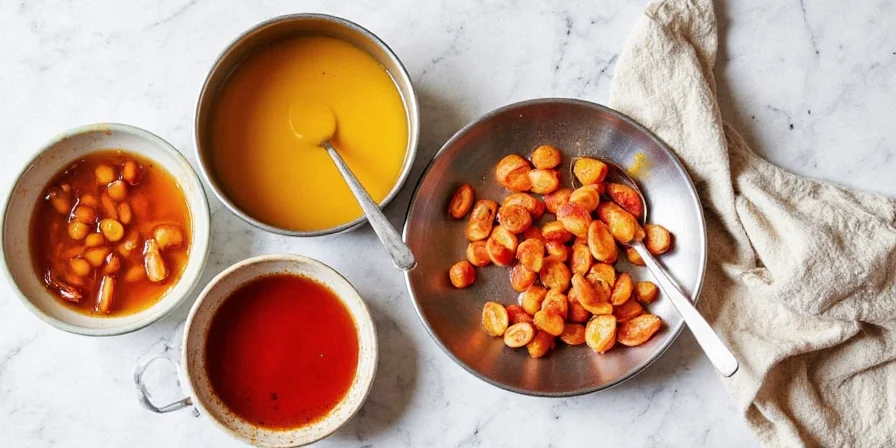What's the difference between stock and broth? The answer is simpler than most chefs admit: stock is unseasoned, while broth is seasoned and ready to eat. This fundamental distinction affects everything from cooking time to recipe substitution. While many sources overcomplicate this basic culinary concept, understanding this core difference solves 90% of confusion in the kitchen. This guide explains the practical differences with clear examples, common substitutions, and when professional-level spice techniques actually matter.
Table of Contents
- Stock vs Broth: The Simple Truth
- Why Everyone Gets This Wrong
- Cooking Time & Method Differences
- When You Can Substitute Stock for Broth (and Vice Versa)
- Professional Spice Techniques That Actually Work
- 5 Most Common Stock/Broth Mistakes
- How to Store Properly (Freezing Tips)
- FAQ: Quick Answers to Real Questions
Stock vs Broth: The Simple Truth
Forget confusing culinary jargon. Here's what matters for home cooking:
| Feature | Stock | Broth |
|---|---|---|
| Seasoning | No salt or spices added | Seasoned and ready to eat |
| Purpose | Flavor base for sauces/soups | Finished product you drink |
| Ingredients | Bones, vegetables, herbs (no salt) | Meat, vegetables, salt, spices |
| Cooking Time | 3-6 hours (bones) | 45-90 minutes (meat) |
| When to Use | When making pan sauces or complex soups | When serving broth directly (like miso soup) |
"Stock is your canvas; broth is the painting." Most confusion comes from restaurants using "broth" on menus when they've actually made stock. For home cooking, the seasoning difference is what truly matters.

Why Everyone Gets This Wrong
Three reasons cause endless confusion:
- Restaurant terminology: Chefs call everything "stock" behind the scenes, then season it and call it "broth" on menus
- Packaged product labeling: Grocery stores label seasoned products as "stock" (like "Swanson Beef Stock") when technically they're broths
- Regional differences: In the UK, "stock" often means what Americans call "broth"
The solution? Ignore labels and check the ingredient list. If salt appears in the first 5 ingredients, it's broth. No salt? It's stock.
Cooking Time & Method Differences
While the seasoning is the true difference, cooking methods follow naturally:
- Stock: Made from bones (creates gelatin), simmered 3-6 hours, no salt added
- Broth: Made from meat (not just bones), simmered 45-90 minutes, salt and spices included
Key insight: You can turn stock into broth in 5 minutes by adding salt and spices. But you cannot remove salt from broth to make stock.

When You Can Substitute Stock for Broth (and Vice Versa)
Follow this simple rule: Always substitute stock for broth, never broth for stock.
Here's why and how:
- Using stock instead of broth: Add 1/2 tsp salt per cup + your favorite spices
- Using broth instead of stock: Only works if you reduce other salt in recipe (risky for beginners)
- Store-bought solutions: "No-sodium" versions are actually stocks; regular versions are broths
Professional chefs always keep unsalted stock on hand, then season to taste for each dish.
Professional Spice Techniques That Actually Work
Once you understand the basic difference, these spice techniques help elevate your broth:
- Layering method: Add hardy spices (bay leaves, peppercorns) at start, delicate ones (fresh herbs) in last 10 minutes
- Dry blooming: Toast whole spices in dry pan before adding to liquid for deeper flavor
- Finishing touch: Stir in fresh herb-infused oil just before serving to preserve volatile aromas
- Acid balance: Add citrus or vinegar in final 5 minutes to brighten flavors without bitterness
- Temperature control: Keep broth below 185°F (85°C) to prevent spice bitterness

5 Most Common Stock/Broth Mistakes (and Fixes)
- Mistake: Using salted stock in a recipe calling for unsalted
Solution: Reduce other salt by 25% or rinse vegetables thoroughly - Mistake: Overcooking broth until spices turn bitter
Solution: Remove hard spices after 30 minutes; add delicate herbs later - Mistake: Confusing bone broth with stock
Solution: Bone broth = stock simmered extra long (12-24 hours) for more collagen - Mistake: Using broth when recipe specifies stock
Solution: Omit additional salt in recipe or use half broth/half water - Mistake: Cloudy broth from boiling too hard
Solution: Simmer gently (small bubbles only) and avoid stirring

How to Store Properly (Freezing Tips)
Maximize shelf life with these methods:
- Refrigeration: Up to 5 days (broth); up to 3 days (stock with meat)
- Freezing: Pour into ice cube trays, then transfer to bags (1 cube = 1 oz)
- Best practice: Freeze stock unseasoned, then add salt/spices when using
- Thawing: Always thaw in refrigerator, never at room temperature
Pro tip: Label containers with date AND whether it's stock or broth to avoid future confusion.
Frequently Asked Questions
Can I use chicken stock instead of broth in soup?
Yes, and it's actually better! Add 1/2 tsp salt per cup plus your preferred spices. This gives you complete control over seasoning. Never substitute regular broth for stock, as you can't remove excess salt.
Is bone broth the same as stock?
Bone broth is a type of stock simmered much longer (12-24 hours vs 3-6 hours) to extract maximum collagen. Both are unseasoned, but bone broth has thicker consistency. You still need to add salt and spices to make it into broth.
Why does my homemade broth taste flat?
Three likely reasons: 1) You're using stock without adding salt/spices, 2) You're overcooking delicate spices, or 3) Missing acid component. Fix: Add 1 tsp vinegar or citrus in the last 5 minutes of cooking to brighten flavors.
Can I make broth from store-bought stock?
Absolutely. Simmer 4 cups store stock with 1 tsp salt, 1/4 onion, 1 celery stalk, and 2 peppercorns for 20 minutes. Strain and add fresh herbs. This transforms basic stock into flavorful broth ready for immediate use.
What's the difference between consommé and broth?
Consommé is a clarified broth where impurities have been removed through a special egg white clarification process. It starts as broth but becomes crystal clear through additional preparation. Stock would be too cloudy to clarify properly.










 浙公网安备
33010002000092号
浙公网安备
33010002000092号 浙B2-20120091-4
浙B2-20120091-4